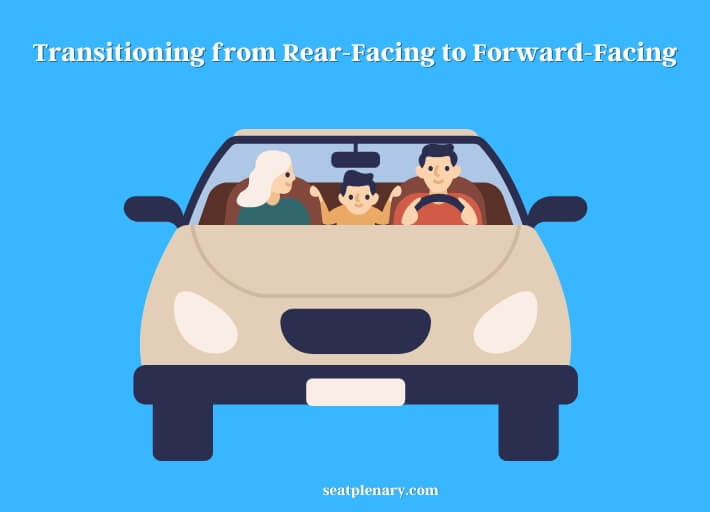As parents, our top priority is always the safety of our children. This is especially true when it comes to traveling in a vehicle. The question often arises: “Are rear facing car seats safer than forward facing?” To help answer this, we’ve delved into the research and have some insights that might surprise you. Buckle up, because we’re about to take a ride through the world of car seat safety.

The Birth of Car Seats: A Quick History
Before we tackle our main question, let’s have a quick detour into the past. When were car seats invented, and why?
The Early Days
Car seats were first invented in the 1960s, but not with safety in mind. These early models were essentially just crates that kept children contained, allowing parents to focus on the road. The first safety car seat was developed in 1962 by Britax, but widespread use of these seats didn’t come about until the 1980s.
Changes in Legislation and Awareness
Over time, with increasing awareness and changes in legislation, the use of car seats has become not only common but also legally required in many countries. Nowadays, child car seats are designed to offer maximum protection in the event of a collision. However, the question remains – is rear-facing safer than forward-facing?
Understanding Car Crash Dynamics
To answer the question, we first need to understand car crash dynamics. What happens during a crash, and how can car seats protect children?
Impact Forces and Child Physiology
In a car crash, passengers experience rapid deceleration. For children, whose bodies are still developing, this sudden force can be particularly damaging. A rear-facing car seat is designed to distribute these forces across a child’s entire body, reducing the risk of serious injury.
Why Rear-Facing Seats Are Safer
With the forces of a crash dispersed more evenly across the body, the fragile head, neck, and spine are better protected. According to a study by the American Academy of Pediatrics, rear-facing car seats are up to 500% safer for children under two years old.
Are Rear Facing Car Seats Safer than Forward Facing?
Based on crash dynamics and child physiology, it’s clear that rear-facing car seats offer superior protection. But how does this stack up against forward-facing seats?
The Comparative Risks
In a forward-facing seat, the child’s torso is restrained but their head is not. This can lead to a phenomenon known as “head excursion,” where the head moves forward rapidly, putting strain on the neck and spine. In contrast, a rear-facing seat supports the head and prevents this dangerous movement.
Safety Beyond the Statistics
While statistics clearly indicate that rear-facing is safer for young children, this doesn’t mean forward-facing seats are inherently dangerous. It’s critical that the seat is appropriate for the child’s age, weight, and height, and that it’s installed and used correctly. Never underestimate the power of a properly installed and used car seat, regardless of its orientation.
Transitioning from Rear-Facing to Forward-Facing
One of the most common questions parents have is when to switch their child from a rear-facing seat to a forward-facing seat. Let’s dive into that.
When to Make the Switch?
Many parents are eager to switch their child to a forward-facing seat as they grow. However, the American Academy of Pediatrics recommends keeping children in rear-facing seats for as long as possible, at least until they reach the seat’s maximum weight and height limits, which often isn’t until around 4 years old.

The Importance of Patience
Remember, each transition—from rear-facing to forward-facing, from car seat to booster seat, from booster seat to seat belt—decreases the level of protection for your child. There’s no need to rush! Patience is key in ensuring your child’s safety on the road.
At a Glance: Rear Facing Car Seats vs Forward Facing
| Rear-Facing Car Seats | Forward-Facing Car Seats | |
|---|---|---|
| Advantages | ||
| Safety | Considered safer for children under 2 years old due to better support for the head, neck, and spine in a collision. | Less optimal for protecting the head, neck, and spine, but better for children who have outgrown rear-facing seats in terms of weight and height. |
| Space Usage | Often more compact, requiring less space in the vehicle, which can be beneficial in smaller cars. | Tend to be bulkier and might require more space, but many models come with additional features like cup holders or toy bars. |
| Child’s Comfort | Better for newborns and smaller babies as they are in a reclining position. | More comfortable for older toddlers who might want to sit up and see out of the window. |
| Disadvantages | ||
| Limited Visibility | The child can’t see out of the front window, which can lead to boredom on longer trips. | Better visibility for the child, which can be more engaging on longer trips. |
| Convenience | Can be difficult to move a sleeping child from the car without waking them. | Easier to get the child in and out of the car, especially if they’re awake and cooperating. |
| Lifespan | Most children outgrow rear-facing car seats by the age of 2-3 years, so parents might need to buy a new seat sooner. | Can be used for a longer period as they are designed for older toddlers and can often convert into a booster seat. |
| Space for Driver and Front Passenger | May require front seats to be pushed forward in smaller vehicles, reducing legroom for adults. | Generally require less adjustment of the front seats. |
Read more:
- Rear-Facing Car Seats: Is There a Height Limit?
- Oregon’s Rear-Facing Car Seat Laws
- North Carolina Car Seat Laws – Focusing on Rear Facing
Choosing the Right Car Seat
Whether you opt for rear-facing or forward-facing, choosing the right car seat can be daunting. Here are some factors to consider.
Compatibility with Your Vehicle
Not all car seats fit in all vehicles. Before purchasing, make sure the car seat you choose is compatible with your vehicle’s make and model.
Ease of Installation and Use
A car seat that’s difficult to install or use may not offer the best protection. Look for a seat with clear instructions and straightforward use.
Comfort for Your Child
If your child is uncomfortable in their car seat, they may fuss, which can distract the driver. Make sure the car seat you choose is comfortable and suits your child’s needs.
The Following Resources Will Help You Learn More
Delve into the history and best practices for car seat safety through a range of resources designed to empower parents and caregivers. Goodhousekeeping.com’s fascinating article, “The Evolution of Kids Car Seats,” provides a comprehensive overview of how car seats have developed over the years. The safety standards, designs, and features have evolved significantly, contributing to a steady decrease in child fatalities and injuries on the road.
For a rapid fire view of this evolution, whattoexpect.com offers a succinct snapshot in their video “100 Years of Car Seat History in (About) 60 Seconds.” This resource provides a quick yet informative overview of the progress made in car seat safety, capturing the journey from rudimentary safety equipment to today’s highly engineered child restraint systems.
To understand the practical aspects of car seat safety, several video resources are incredibly helpful. Phoenix Children’s YouTube channel offers an enlightening video titled “Car Seat Safety,” which demonstrates correct installation techniques and common errors to avoid. ‘HealthLinc’ also shares practical insights through their video, “How to Safely Buckle a Child in a Car Seat.“
Finally, for a detailed age-based guide, ‘ChildPassengerSafety’ presents “Car Seat Safety By Age: Infants in Rear-facing Seats.” This extensive guide covers the specifics of rear-facing seats, emphasizing why they’re the safest option for infants and how to properly install them. Together, these resources provide a rounded understanding of car seat safety, helping to ensure your child’s safety while on the road.
FAQs
Are rear facing car seats safer than forward facing?
Yes, rear-facing car seats have been shown to be safer than forward-facing seats, particularly for children under the age of 2. They offer better support for the head, neck, and spine in the event of a collision.
When should I switch my child to a forward-facing seat?
It’s recommended to keep your child in a rear-facing seat for as long as possible, typically until they reach the seat’s maximum weight or height limit, which can be around the age of 4.
Are forward-facing car seats unsafe?
No, forward-facing car seats are not inherently unsafe. However, they do offer less protection than rear-facing seats, particularly for very young children. It’s essential to ensure the seat is appropriate for your child’s age, weight, and height.
How can I ensure my car seat is installed correctly?
Follow the manufacturer’s instructions carefully when installing your car seat. You can also visit a local car seat inspection station, where a certified technician can check your installation.
What should I consider when buying a car seat?
Consider your vehicle compatibility, ease of installation and use, and the comfort of your child. It’s also crucial to check that the seat meets safety standards.
Can I use a second-hand car seat?
It’s recommended to buy new car seats. If you do consider a second-hand car seat, ensure it has never been in a crash, it’s not past its expiration date, and it comes with its original instructions and parts.
Conclusion
When it comes to car seat safety, there’s a clear winner: rear-facing car seats offer more protection than their forward-facing counterparts. However, the most critical factor is choosing the right seat for your child’s age, weight, and height, and ensuring it’s correctly installed. Safety isn’t just about statistics—it’s about making informed decisions that suit your child and your vehicle.
